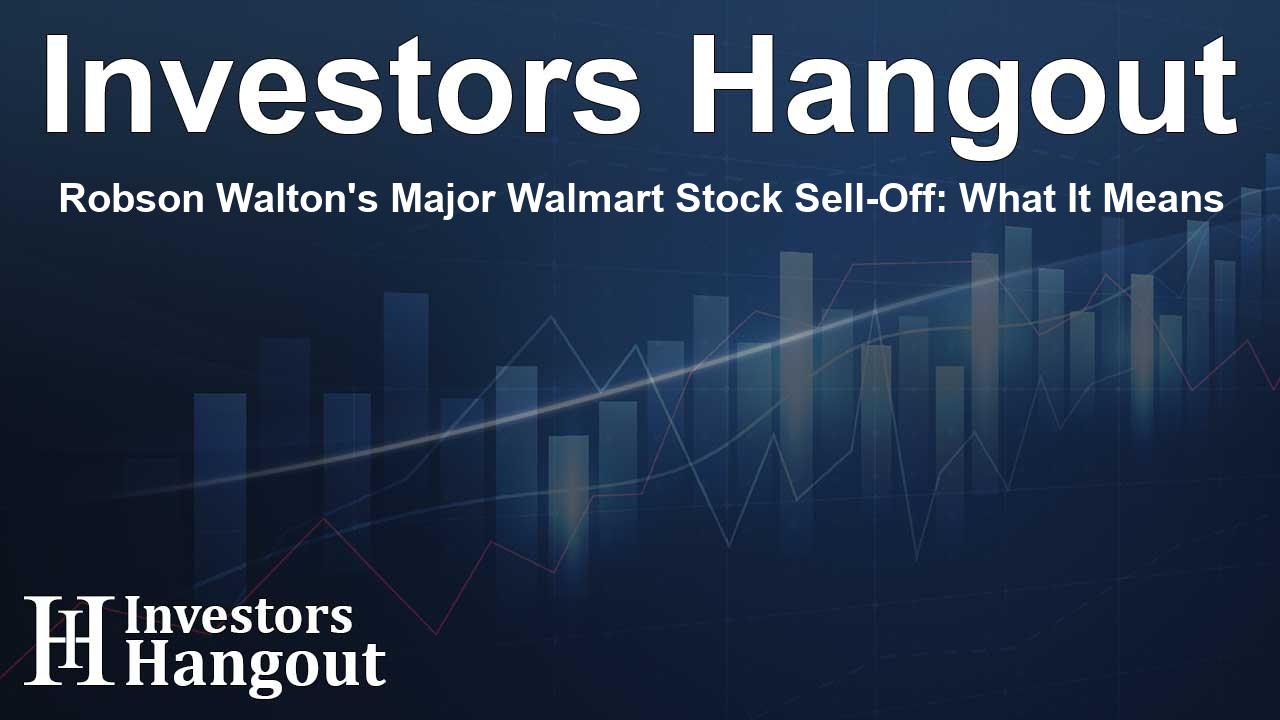Robson Walton's Major Walmart Stock Sell-Off: What It Means

Robson Walton's Major Walmart Stock Sell-Off
Recently, a remarkable decision came to light when Robson Walton, a notable 10% owner of Walmart, executed a significant insider sale amounting to $170.98 million. This event raises many intriguing questions about the motivations behind such a large transaction and its implications for the retail giant.
Details of the Transaction
The insider sell involves Walton divesting 2,163,616 shares of Walmart. This was disclosed in a formal SEC filing, which indicates the need for transparency in major stock transactions by company leaders. At the time of the announcement, Walmart's stocks were trading at $78.96, marking a 1.18% increase.
Understanding Walmart: A Retail Powerhouse
Walmart has established itself as the leading retail chain in the United States, mainly due to its commitment to delivering the lowest prices while ensuring high operational efficiency. This strategy has proven effective, driving significant customer traffic and enhancing product turnover. The retailer revolutionized shopping with the launch of its first supercenter in 1988, presenting a convenient one-stop solution for consumers.
Currently, Walmart operates over 4,600 stores in the U.S. and more than 10,000 globally, capturing a substantial market share. In fiscal years past, Walmart generated approximately $440 billion in domestic sales, with an additional $86 billion from Sam's Club and $115 billion internationally, serving a staggering 240 million customers each week.
Evaluating Walmart's Financial Performance
When assessing Walmart's financial performance, it’s evident there's a positive trajectory. For the past three months, Walmart has experienced a revenue growth rate of 4.77%. However, this growth is slightly less than the industry average in the Consumer Staples sector, indicating that Walmart still faces some challenges amidst competitive pressures.
-
Gross Margin Performance: Walmart boasts a commendable gross margin of 25.11%, reflecting its strong ability in managing costs while maintaining profit levels.
-
Earnings Per Share (EPS): With an EPS of 0.56, Walmart’s performance exceeds the industry average, showcasing the company’s resilience in generating earnings.
Debt Management Strategy: The company maintains a prudent approach to debt, with a debt-to-equity ratio of 0.73, which is favorable compared to industry standards.
Decoding Walmart’s Valuation Metrics
-
Price to Earnings (P/E) Ratio: Currently, Walmart's P/E ratio of 40.65 exceeds the average, suggesting that investors might consider the stock overvalued based on market sentiment.
-
Price to Sales (P/S) Ratio: With a P/S ratio of 0.95, Walmart again indicates potential overvaluation in the context of sales performance compared to peers.
-
EV/EBITDA Ratio: Walmart's EV/EBITDA of 18.43 also surpasses industry benchmarks, positioning it with a strong market value.
Walmart's market capitalization is significant, indicating not only size but also strong recognition in the competitive retail space.
Understanding the Role of Insider Transactions
Insider transactions can provide valuable insights. By law, insiders—comprised of executives and owners—are required to disclose their stock transactions publicly. When insiders buy shares, it often signals confidence in the company’s future, whereas a sell-off, like Walton's, can be interpreted in various ways and does not always imply negativity.
What Investors Should Know About Insider Trading Codes
For investors, it’s crucial to understand the specifics of insider trading codes noted in SEC filings. For instance, a P indicates a purchase and S signifies a sale. These codes help investors grasp the broader implications of insider trading trends in real time.
Conclusion: The Takeaway for Walmart's Future
While Walton’s decision to sell a significant portion of his Walmart shares may cause some speculation, it’s essential to view this action within the broader market landscape. Walmart remains a resilient and competitive player in the retail sector, with a strong business model and financial performance.
Frequently Asked Questions
What was the total value of Robson Walton's insider sale?
Robson Walton sold 2,163,616 shares of Walmart, totaling approximately $170.98 million.
How does Walmart’s recent financial performance look?
Walmart has recorded a revenue growth rate of 4.77% over the past three months, indicating a positive trend despite facing challenges in comparison to the industry averages.
What does Walmart's gross margin indicate?
The gross margin of 25.11% highlights Walmart's effective cost management and profitability within the retail sector.
What should investors consider regarding insider transactions?
Insider transactions can provide insights into company management’s confidence levels, though it’s important to analyze the reasons behind sales and purchases thoroughly.
What are the implications of Walmart's P/E ratio?
Walmart's P/E ratio of 40.65 suggests that the company's stock may be seen as overvalued compared to industry averages, which can influence investor perception and decisions.
About Investors Hangout
Investors Hangout is a leading online stock forum for financial discussion and learning, offering a wide range of free tools and resources. It draws in traders of all levels, who exchange market knowledge, investigate trading tactics, and keep an eye on industry developments in real time. Featuring financial articles, stock message boards, quotes, charts, company profiles, and live news updates. Through cooperative learning and a wealth of informational resources, it helps users from novices creating their first portfolios to experts honing their techniques. Join Investors Hangout today: https://investorshangout.com/
Disclaimer: The content of this article is solely for general informational purposes only; it does not represent legal, financial, or investment advice. Investors Hangout does not offer financial advice; the author is not a licensed financial advisor. Consult a qualified advisor before making any financial or investment decisions based on this article. The author's interpretation of publicly available data shapes the opinions presented here; as a result, they should not be taken as advice to purchase, sell, or hold any securities mentioned or any other investments. The author does not guarantee the accuracy, completeness, or timeliness of any material, providing it "as is." Information and market conditions may change; past performance is not indicative of future outcomes. If any of the material offered here is inaccurate, please contact us for corrections.